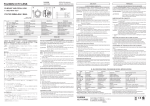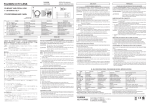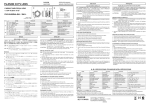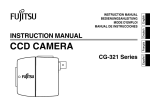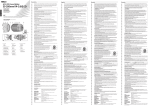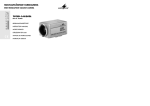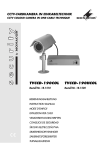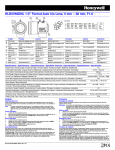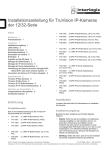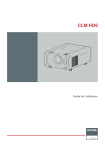Download CCTV-FARBKAMERA TVCCD-400COL
Transcript
CCTV-FARBKAMERA CCTV COLOUR CAMERA TVCCD-400COL Best.-Nr. 19.3560 BEDIENUNGSANLEITUNG INSTRUCTION MANUAL MODE D’EMPLOI ISTRUZIONI PER L’USO MANUAL DE INSTRUCCIONES ® D A CH F B CH E 2 Bevor Sie einschalten ... Wir wünschen Ihnen viel Spaß mit Ihrem neuen MONACOR-Gerät. Bitte lesen Sie vor dem Gebrauch diese Anleitung. Der deutsche Text beginnt auf der Seite 4. GB Before you switch on We wish you much pleasure with your new MONACOR unit. Please read these instructions before use. The English text starts on the page 9. Avant toute utilisation Nous vous remercionsd'avoir choisi un appareil MONACOR et vous prions de lire cette notice. La version française commence à la page 14. I Prima di accendere Vi auguriamo buon divertimento con il Vostro nuovo apparecchio MONACOR. Vi preghiamo di leggere le presenti istruzioni prima dell'uso. Il testo italiano inizia a pagina 19. Antes de la conexión Le agradecemos el haber adquirido un equipo MONACOR. Por favor, lee atentamente las instrucciones de uso. La versión español comienza en la página 24. BLC OFF OFF AGCMIN GAMMA1 AUTO IRIS VIDEO VIDEO OUT FLICKERLESS 1/100S NTSC 1/120S PAL DC 1 2 3 4 5 LEVEL OFF BLC ON SHUTTER AGCMAX GAMMA2 ➀ ➁ 1 2 3 4 5 6 3 4 ➂ 1 3 2 Schalter AUTO IRIS (2) Switch VIDEO DC 7 für AI-Objektiv for AI lens 8 VIDEO DC 9 für DC-Objektiv for DC lens Pin 1 Ausgang/output +12 V Dämpfungsspule -/damp - Pin 2 Ausgang Videosignal/output of video signal Dämpfungsspule +/damp + Pin 3 Masse/ground Antriebsspule +/drive - Pin 4 Masse/ground Antriebsspule -/drive - 10 D A Bitte klappen Sie die Seite 3 heraus. Sie sehen dann immer die beschriebenen Bedienelemente und Anschlüsse. CH 1 Übersicht der Bedienelemente und Anschlüsse 1 BNC-Buchse für den Videoausgang, 1 Vss an 75 Ω 2 Umschalter AUTO IRIS zur Einstellung der Kamera auf den verwendeten Objektivtyp, siehe Tabelle auf der Seite 3 3 Regler LEVEL zum Einstellen des Arbeitspunktes bei Verwendung eines DC-Objektives 4 Stromversorgungsanschluss für 12 V , Mittelkontakt = Pluspol 5 Buchse für den Anschluss eines Objektivs mit automatischer Blendenregelung (Auto Iris), Anschlussbelegung siehe Tabelle auf der Seite 3 6 DIP-Schalter zum Um- oder Ein- und Ausschalten verschiedener Funktionen 1 GAMMA 1/2 Gammakorrektur 0,45 oder 1 2 AGC autom. Verstärkungsregelung 3 SHUTTER elektronischer Verschluss 4 4 BLC Gegenlichtkompensation 5 FLICKERLESS Flimmerkompensation 7 Adapter mit 6,3-mm-Fotogewinde (1/4"); zur Deckenmontage den Adapter auf die Oberseite der Kamera schrauben 8 Feststellschrauben zum Korrigieren des Auflagemaßes für das Objektiv 9 Adapterring zur Montage eines Objektivs mit C-Mount-Gewinde 10 Schutzkappe 2 Hinweise für den sicheren Gebrauch Die Kamera entspricht der EU-Richtlinie 89/336/ EWG für elektromagnetische Verträglichkeit. ● Die Kamera ist nur zur Verwendung im Innenbereich geeignet. Bei einer Außenmontage muss sie in ein wetterfestes Schutzgehäuse eingesetzt werden. ● Schützen Sie die Kamera vor Verschmutzung, Feuchtigkeit und Hitze (zulässiger Einsatztemperaturbereich 0 – 40 °C). ● Verwenden Sie zum Reinigen nur ein trockenes, weiches Tuch, auf keinen Fall Chemikalien oder Wasser. Wird die Kamera zweckentfremdet, falsch angeschlossen, nicht richtig bedient oder nicht fachgerecht repariert, kann für eventuelle Schäden keine Haftung übernommen werden. ● Soll die Kamera endgültig aus dem Betrieb genommen werden, übergeben Sie sie zur umweltgerechten Entsorgung einem örtlichen Recyclingbetrieb. ● 3 Einsatzmöglichkeiten Die PAL-Farbkamera TVCCD-400COL ist speziell für den Einsatz in Videoüberwachungsanlagen konzipiert. Sie ist u. a. mit einer automatischen Verstärkungsregelung (AGC), einem automatischen elektronischen Verschluss (1/50 – 1/100 000 s), einem automatischem Weißabgleich (Bereich 2400 °K bis 11 000 °K) und einer Gegenlichtkompensation ausgestattet. 4 Objektiv Es kann sowohl ein Objektiv mit automatischer Blendenregelung [AI-Objektiv oder DC-Objektiv (AISObjektiv)] als auch ein Objektiv mit manueller Blendeneinstellung verwendet werden. 1) Mit den Umschaltern AUTO IRIS (2) und SHUTTER (6) den verwendeten Objektivtyp einstellen: Objektivtyp videosignalgeregelt gleichspannungsgesteuert (DC) manuelle oder feste Blende Schalter AUTO IRIS Schalter SHUTTER VIDEO OFF DC OFF — SHUTTER (untere Position) D A CH 2) Die Schutzkappe (10) abnehmen. Achtung! Schützen Sie den CCD-BildwandlerChip und die Objektivlinsen vor Staub und Verschmutzung und berühren Sie sie auf keinen Fall mit den Fingern. 3) Bei Verwendung eines C-Mount-Objektivs zuerst den mitgelieferten C-Mount-Adapterring (9) auf die Kamera schrauben und darauf das Objektiv. Bei Verwendung eines CS-Mount-Objektivs den Adapterring (9) ggf. entfernen und das Objektiv direkt auf die Kameravorderseite schrauben. 4) Bei einem Objektiv mit gesteuerter Blende dieses an die Buchse AUTO IRIS (5) anschließen. Bei Be- 5 D A CH darf den beiliegenden Stecker verwenden. Die Buchse hat, abhängig von der Stellung des Schalters AUTO IRIS (2), folgende Pin-Belegung, siehe auch Tabelle auf der Seite 3: Pin Position VIDEO Position DC 1 Stromversorgung Pluspol Dämpfungsspule - 2 Ausgang Videosignal Dämpfungsspule + 3 Masse Antriebsspule + 6 Kamera anschließen 4 Masse Antriebsspule - 1) Die BNC-Ausgangsbuchse VIDEO OUT (1) über ein 75-Ω-Kabel (z. B. VEC-62/10 von MONACOR) mit einem Monitor verbinden. Dabei auf den korrekten 75-Ω-Abschluss am Monitor bzw. bei Serienschaltung am letzten Monitor achten. Bei einer Kabellänge von mehr als 100 m sollte ein Videoverstärker zwischen die Kamera und das lange Kabel geschaltet werden, um die Kabelverluste auszugleichen. Beim Einsatz von mehreren Kameras einen Video-Splitter (z. B. TVSP-46COL von MONACOR) oder einen Kamera-Umschalter (z. B. TVS-40 oder TVS-80 von MONACOR) zwischen die Kameras und den Monitor schalten. Achtung! Um Beschädigung von Kamera oder Objektiv zu vermeiden, vor dem Anschluss des Objektivs die Stellung des Schalters AUTO IRIS und die Pin-Belegung des Steckers überprüfen. 5 Montage Die Kamera kann mit einer Kamerahalterung (z. B. TVH-Serie von MONACOR) an eine Wand oder Decke montiert werden. Dazu befindet sich auf der Unterseite ein Adapter (7) mit einem 6,3-mm-Fotoge- 6 winde (1/4"). Für eine Deckenmontage den Adapter auf die Oberseite der Kamera schrauben. Bei einer Außenmontage muss die Kamera in ein wetterfestes Schutzgehäuse (z. B. TVG-300 von MONACOR) eingesetzt werden. Soll die Kamera ferngesteuert schwenkbar sein, ist ein Kamera-Rotor zu verwenden (z. B. VPT-50 von MONACOR). 2) Die Betriebsspannung von 12 V über einen Kleinspannungsstecker 5,5/2,1 mm (Außen-/Innendurchmesser) an die Versorgungsbuchse (4) [innerer Kontakt = Pluspol] anschließen. Es ist ein elektronisch stabilisiertes Netzgerät mit einer Ausgangsspannung von 12 V erforderlich (z. B. PS12CCD oder PS-128A von MONACOR). Die Stromaufnahme der Kamera beträgt 200 mA. 7 Inbetriebnahme 1) Nach dem Anlegen der Betriebsspannung ist die Kamera betriebsbereit. 2) Nach dem Einschalten des Monitors die Kamera auf den Überwachungsbereich ausrichten. Achten Sie darauf, dass kein Sonnenlicht direkt auf die Objektivlinsen trifft. Anderenfalls könnte der CCDBildwandler-Chip beschädigt werden! 3) Am Objektiv die Entfernung einstellen. Bei einem Objektiv mit manuell einstellbarer Blende diese auf optimale Bildwiedergabe (Schärfentiefe und Helligkeit) einstellen. 4) Ist bei korrekt eingestellter Entfernung das Bild unscharf, das Auflagemaß für das Objektiv korrigie- ren. Dazu die Feststellschrauben (8) lösen. Durch Verdrehen des Gewinderings (zusammen mit dem Objektiv und eventuell dem Adapterring) ein scharfes Bild einstellen. Anschließend die Schrauben wieder festziehen. D A CH 5) Bei Verwendung eines Objektivs mit gleichspannungsgesteuerter Blende (DC-Objektiv) lässt sich der Arbeitspunkt der Regelung korrigieren, falls das Bild zu dunkel oder zu hell erscheint: Durch Verdrehen des Reglers LEVEL (3) mit einem kleinen Schraubendreher die optimale Helligkeit einstellen. Bei Verwendung eines Objektivs mit videosignalgeregelter Blende befinden sich Regler am Objektiv. 6) Einstellung der DIP-Schalter (6) GAMMA 1/GAMMA 2 (Gammakorrektur) Die Standardeinstellung ist GAMMA 1 für eine Grauwertumsetzung von 0,45. Lässt sich der Kontrast am Monitor nicht optimal einstellen, den Schalter in die Position GAMMA 2 stellen. AGC (automatische Verstärkungsreglung) Die Standardeinstellung ist AGC MIN. Bei starken Lichtstärkeschwankungen kann ggf. in der 7 D A CH Position AGC MAX ein besseres Ausregeln durch die Kamera erreicht werden. SHUTTER (elektronischer Verschluss) Die Standardeinstellung für Objektive mit geregelter Blende ist OFF. Bei ausreichender Helligkeit und sich schnell bewegenden Objekten kann in der unteren Position SHUTTER eine größere Schärfe erreicht werden. BLC (Gegenlichtkorrektur) Stört kein Gegenlicht, den Schalter in die Position OFF stellen, sonst in die Position BLC ON. FLICKERLESS (Flimmerkompensation) Die Standardeinstellung ist OFF. Wenn das Bild auf dem Monitor flimmert, den Schalter in die obere Position FLICKERLESS stellen. 8 Technische Daten Bildabtaster:. . . . . . . . . . . . . 8,5-mm-CCD-Chip (1/3") Farbsystem:. . . . . . . . . . . . . PAL Synchronisation: . . . . . . . . . horizontal 15 625 Hz, vertikal 50 Hz (CCIR) Anzahl der Bildpunkte:. . . . . hor. 500, vertikal 582 8 Auflösung: . . . . . . . . . . . . . . 420 Linien Mindestbeleuchtung: . . . . . . 0,5 Lux bei Objektiv 1 : 0,75 autom. elektron. Verschluss: 1/50 – 1/100 000 s Signal/Rauschabstand: . . . . > 50 dB Ausgänge Video: . . . . . . . . . . . . . . . 1 Vss/75 Ω (FBAS) Blendenregelung: . . . . . . 1 Vss, 10 Ω Gammakorrektur Gamma 1: . . . . . . . . . . . . 0,45 Gamma 2: . . . . . . . . . . . . 1 autom. Verstärkungsreglung AGC min.: . . . . . . . . . . . . normaler Modus AGC max.: . . . . . . . . . . . +6 dB zulässige Einsatztemperatur: 0–40 °C Stromversorgung: . . . . . . . . 12 V , 200 mA Abmessungen (B x H x T): . 48 x 43 x 143 mm Gewicht, ohne Objektiv:. . . . 190 g Laut Angaben des Herstellers. Änderungen vorbehalten. Please unfold page 3. Then you can always see the operating elements and connections described. 1 Operating Elements and Connections 1 BNC jack for the video output, 1 Vpp at 75 Ω 2 Selector switch AUTO IRIS for adjusting the camera to the lens type used, see table on page 3 3 Control LEVEL for adjusting the operating point when using a DC lens 4 Power supply connection for 12 V , centre contact = positive pole 5 Jack for connecting a lens with automatic iris control (auto iris lens), for pin configuration see table on page 3 6 DIP switches for selecting, activating and deactivating various functions 1 GAMMA 1/2 gamma correction 0.45 or 1 2 AGC automatic gain control 3 SHUTTER electronic shutter 4 BLC backlight compensation 5 FLICKERLESS flicker compensation 7 Adapter with 6.3 mm (1/4") thread; for ceiling suspension, screw the adapter onto the upper side of the camera 8 Setscrews for adjusting the mechanical focus setting for the lens 9 Adapter ring for mounting a lens with C-mount thread 10 Lens cover GB 2 Safety Notes The camera corresponds to the directive for electromagnetic compatibility 89/336/EEC. ● The camera is suitable for indoor use only. For outside installation, the camera must be mounted into a weatherproof outdoor housing. ● Protect the camera against impurities, humidity, and heat (admissible ambient temperature range 0 – 40 °C). ● For cleaning only use a dry, soft cloth; never use chemicals or water. ● No liability for any damage will be accepted if the camera is used for other purposes than originally in- 9 tended, if it is not correctly connected or operated or not repaired in an expert way. GB ● If the camera is to be put out of operation definitively, take it to a local recycling plant for a disposal which is not harmful to the environment. Lens type Switch AUTO IRIS Switch SHUTTER video signal controlled VIDEO OFF DC controlled DC OFF — SHUTTER (lower position) manual or fixed iris 3 Applications The PAL colour camera TVCCD-400COL is specially designed for applications in video surveillance systems. Among other features it is provided with an automatic gain control (AGC), an automatic electronic shutter (1/50 – 1/100 000 s), an automatic white balance (range 2400 °K to 11 000 °K), and a backlight compensation. 4 Lens It is possible to use a lens with automatic iris control [AI lens or DC lens (AIS lens)] or a lens with manual iris control. 1) Adjust the lens type used with the selector switches AUTO IRIS (2) and SHUTTER (6): 10 2) Remove the lens cover (10). Attention! Protect the CCD image sensor chip and the lenses of the lens assembly against dust and other impurities; never touch them with your fingers. 3) When using a C-mount lens, screw the supplied C-mount adapter ring (9) onto the camera first, then screw the lens onto the ring. When using a CS-mount lens, remove the adapter ring (9), if required, then screw the lens directly onto the face of the camera. 4) When using an auto iris lens, connect it to the jack AUTO IRIS (5). If required, use the supplied plug. Depending on the position of the switch AUTO IRIS (2), the jack has the following pin configuration (also see table on page 3): Pin Position VIDEO Position DC 1 positive pole of power supply damp - 2 output of video signal damp + 3 ground drive + 4 ground drive - Attention! Prior to connecting the lens, check the position of the switch AUTO IRIS and the pin configuration of the plug to prevent damage to the camera or the lens. 5 Mounting The camera can be mounted to a wall or ceiling by means of a mounting bracket (e. g. MONACOR TVH series). For this purpose, an adapter (7) with a 6.3 mm (1/4") thread is provided on the lower side of the camera. For ceiling suspension, screw the adapter onto the upper side of the camera. For outside installation, the camera must be placed in a weatherproof outdoor housing (e. g. MONACOR TVG-300). For remote-controlled panning of the camera, use a pan/tilt head (e. g. MONACOR VPT-50). GB 6 Connection 1) Connect the BNC output jack VIDEO OUT (1) to a monitor via a 75 Ω cable (e. g. MONACOR VEC-62/10). Observe the correct 75 Ω termination on the monitor or, in case of series connection, on the last monitor. With a cable length exceeding 100 m, a video amplifier should be inserted between the camera and the long cable to compensate cable losses. When using several cameras, insert a video splitter (e. g. MONACOR TVSP-46COL) or a camera switcher (e. g. MONACOR TVS-40 or TVS-80) between the cameras and the monitor. 2) Connect the operating voltage of 12 V to the power supply jack (4) via a low-voltage plug 5.5/ 2.1 mm (outside/inside diameter) [inner contact = positive pole]. An electronically regulated power supply unit with an output voltage of 12 V is re- 11 GB quired (e. g. MONACOR PS-12CCD or PS-128A). The current consumption of the camera is 200 mA. 7 Operation 1) After applying the operating voltage, the camera is ready for operation. 2) After switching on the monitor, align the camera to the surveillance zone in such a way that the lenses of the lens assembly are not exposed to direct sunlight, otherwise the CCD image sensor chip might be damaged! 3) Adjust the distance on the lens. In case of a lens with manual iris control, adjust the iris to optimum picture reproduction (depth of focus and brightness). 4) If the picture is not sharp despite a correctly adjusted distance, readjust the mechanical focus setting for the lens. For this purpose, release the setscrews (8). Bring the picture into focus by turning the threaded ring (together with the lens and the adapter ring, if required). Then retighten the screws. 12 5) In case of a DC controlled lens, the operating point of the control can be readjusted if the picture is too dark or too bright: Adjust an optimum brightness by turning the control LEVEL (3) with a small screwdriver. When using a lens with video signal controlled iris, the controls can be found on the lens. 6) Adjustment of the DIP switches (6) GAMMA 1/GAMMA 2 (gamma correction) The standard adjustment is GAMMA 1 for a grey scale conversion of 0.45. If an optimum adjustment of the contrast on the monitor is impossible, set the switch to the position GAMMA 2. AGC (automatic gain control) The standard adjustment is AGC MIN. In case of great variations in the luminous intensity, it may be possible to obtain an optimum control by the camera in the position AGC MAX. SHUTTER (electronic shutter) The standard adjustment for lenses with iris control is OFF. In case of sufficient brightness and fast-moving objects, enhanced focussing can be obtained in the lower position SHUTTER. BLC (backlight compensation) Without any disturbing backlight, set the switch to position OFF, otherwise to position BLC ON. FLICKERLESS (flicker compensation) The standard adjustment is OFF. In case of flickering of the picture on the monitor, set the switch to the upper position FLICKERLESS. 8 Specifications Image sensor: . . . . . . . . . . . 8.5 mm (1/3") CCD chip Colour system:. . . . . . . . . . . PAL Synchronization: . . . . . . . . . horizontal 15 625 Hz, vertical 50 Hz (CCIR) Number of pixels:. . . . . . . . . hor. 500, vertical 582 Resolution:. . . . . . . . . . . . . . 420 lines Minimum illumination: . . . . . 0.5 lux for lens 1 : 0.75 Automatic electronic shutter: 1/50 – 1/100 000 s S/N ratio: . . . . . . . . . . . . . . . > 50 dB Outputs video: . . . . . . . . . . . . . . . 1 Vpp/75 Ω (FBAS) iris control:. . . . . . . . . . . . 1 Vpp, 10 Ω Gamma correction Gamma 1: . . . . . . . . . . . . Gamma 2: . . . . . . . . . . . . Automatic gain control AGC min.: . . . . . . . . . . . . AGC max.: . . . . . . . . . . . Admissible ambient temperature: . . . . . . . . . . . . Power supply: . . . . . . . . . . . Dimensions (W x H x D): . . . Weight without lens: . . . . . . GB 0.45 1 normal mode +6 dB 0 – 40 °C 12 V , 200 mA 48 x 43 x 143 mm 190 g According to the manufacturer. Subject to technical change. 13 F Ouvrez le présent livret page 3 de manière à visualiser les éléments et branchements. B CH 14 1 Eléments et branchements 1 Prise BNC pour la sortie vidéo, 1 Vcc/75 Ω 2 Commutateur AUTO IRIS pour régler la caméra sur le type d’objectif utilisé, voir tableau page 3 3 Potentiomètre de réglage LEVEL pour régler le point de travail si on utilise un objectif à commande par tension DC 4 Borne de connexion alimentation pour une tension 12 V , contact médian = pôle plus 5 Prise pour brancher un objectif à commande automatique de réglage (auto iris) ; voir tableau page 3 pour la configuration 6 Interrupteurs DIP pour activer/désactiver/commuter diverses fonctions : 1 GAMMA 1/2 correction gamma 0,45 ou 1 2 AGC adaptation automatique d’un niveau de sortie constant selon les variations de lumière 3 SHUTTER obturation électronique 4 BLC compensation du contre-jour 5 FLICKERNESS compensation scintillement 7 Adaptateur avec filetage 6,3 mm (1/4") ; pour un montage au plafond, vissez l’adaptateur sur la face supérieure de la caméra 8 Vis de réglage pour corriger les réglages de l’objectif 9 Anneau adaptateur pour monter un objectif à filetage C-Mount 10 Cache de protection 2 Conseils d’utilisation et de sécurité La caméra répond à la norme européenne 89/336/ CEE relative à la compatibilité électromagnétique. ● La caméra n’est conçue que pour une utilisation en intérieur. Pour un montage en extérieur, elle doit être placée dans un boîtier de protection étanche. ● Protégez la caméra de la poussière, de l’humidité et de la chaleur (plage de température de fonctionnement autorisée : 0 – 40 °C). ● Pour la nettoyer, utilisez un chiffon sec et doux, en aucun cas de produits chimiques ou d’eau. ● Nous déclinons toute responsabilité en cas de dommage si la caméra est utilisée dans un but autre que celui pour lequel elle a été conçue, si elle n’est pas correctement branchée, utilisée ou réparée par une personne habilitée. ● Lorsque la caméra est définitivement retirée du marché, vous devez la déposer dans une usine de recyclage de proximité pour contribuer à son élimination non polluante. 3 Possibilités de fonctionnement La caméra PAL couleur TVCCD-400COL est spécialement conçue pour une utilisation dans des installations de surveillance vidéo. Elle est dotée d’une adaptation automatique d’un niveau de sortie constant selon les variations de lumière (AGC), d’une obturation électronique automatique (1/50 – 1/100 000 s), d’une compensation automatique du blanc (plage 2400 °K à 11 000 °K) et d’une compensation du contre-jour. 4 Objectif Il est possible d’utiliser un objectif à commande automatique de diaphragme [objectif Al ou objectif DC (AIS)] tout comme un objectif à réglage manuel de diaphragme. 1) Avec le commutateur AUTO IRIS (2), et le interrupteur SHUTTER (6), réglez le type d’objectif utilisé : interrupteur interrupteur Type objectif AUTO IRIS SHUTTER A commande par VIDEO OFF signal vidéo A commande par DC OFF tension DC Diaphragme à réSHUTTER — glage manuel ou fixe (position inférieure) F B CH 2) Retirez le cache de protection (10). Attention ! Protégez la puce CCD et les lentilles de l’objectif de la poussière et de toute salissure, ne les touchez jamais avec les doigts. 3) Si vous utilisez un objectif C-Mount, vissez tout d’ abord l’anneau adaptateur C-Mount livré (9) sur la caméra et vissez l’objectif dessus. Si vous utilisez un objectif CS-Mount, retirez l’anneau (9) si besoin et vissez directement l’objectif sur la face avant de la caméra. 4) Dans le cas d’un objectif à commande de diaphragme par tension, connectez-le à la prise AUTO IRIS (5). Si besoin, utilisez la fiche livrée. La 15 F B CH prise a, en fonction de la position du commutateur AUTO IRIS (2) la configuration suivante, voir tableau sur la page 3 : position DC Pin position VIDEO 1 alimentation pôle plus bobine atténuation - 2 sortie signal vidéo bobine atténuation + 6 Branchements de la caméra 3 masse bobine moteur + 4 masse bobine moteur - 1) Reliez la prise de sortie BNC VIDEO OUT (1) via un câble 75 Ω (VEC-62/10 de MONACOR p. ex.) à un moniteur. Veillez à ce que le branchement 75 Ω sur le moniteur ou, pour un branchement en série, sur le dernier moniteur, soit correctement effectué. Pour une longueur de câble supérieure à 100 m, il est conseillé d’installer un amplificateur vidéo entre la caméra et le long câble de manière à compenser les pertes en ligne. Si vous utilisez plusieurs caméras, un répartiteur vidéo (TVSP-46COL de MONACOR p. ex.) ou un sélecteur de caméra (TVS-40 ou TVS-80 de MONACOR p. ex.) doit être branché entre les caméras et le moniteur. 2) Connectez la tension de fonctionnement 12 V via un adaptateur 5,5/2,1 mm (diamètre extérieur/ diamètre intérieur) à la prise d’alimentation (4) Attention : Pour éviter tout dommage sur la caméra ou l’objectif, vérifier la position du commutateur AUTO IRIS et la configuration de la fiche avant de brancher l’objectif. 5 Montage La caméra peut être montée avec un support de caméra (p. ex. série TVH- de MONACOR) à un mur ou un plafond. Pour ce faire, un adaptateur (7) avec un filetage 6,3 mm (1/4") se trouve sur la face inférieure. Pour un montage au plafond, vissez l’adaptateur sur la face supérieure de la caméra. 16 Pour un montage en extérieur, la caméra doit être placée dans un boîtier de protection étanche (TVG300 de MONACOR par exemple). Si la caméra doit être orientée à distance, un rotor de caméra doit être utilisé (VPT-50 de MONACOR p. ex.). [contact intérieur : pôle plus]. Une alimentation stabilisée électroniquement avec une tension de sortie de 12 V est nécessaire (PS-12CCD ou PS-128A de MONACOR p. ex.). La consommation est de 200 mA. 7 Fonctionnement 1) Une fois la tension de fonctionnement appliquée, la caméra est prête à fonctionner. 2) Une fois le moniteur allumé, dirigez la caméra sur la zone à surveiller. Veillez à ce qu’aucun rayon du soleil n’éclaire directement les lentilles de l’objectif, la puce CCD pourrait être endommagée. 3) Sur l’objectif, réglez la distance : pour un objectif à réglage manuel de diaphragme, réglez-la pour une restitution optimale de l’image (profondeur de champ et luminosité). 4) Si l’image manque de netteté malgré un réglage correct de la distance, il convient d’effectuer certains réglage sur l’objectif : desserrez les vis de réglages (8). En tournant l’anneau fileté (avec l’objectif et le cas échéant l’anneau adaptateur), réglez une image nette. Revissez ensuite les vis. 5) Si vous utilisez un objectif à commande par tension DC (objectif DC), le point de travail du réglage peut être corrigé dans le cas où l’image est trop sombre ou trop claire. En tournant le potentiomètre de réglage LEVEL (3) avec un petit tournevis, réglez la luminosité optimale. Si vous utilisez un objectif à commande de diaphragme par signal vidéo, les réglages se trouvent sur l’objectif. 6) Réglage des interrupteurs DIP (6) GAMMA 1/GAMMA 2 (correction gamma) Le réglage standard est GAMMA 1 pour une conversion des niveaux de gris de 0,45. Si le contraste sur le moniteur ne peut être réglé de manière optimale, mettez le sélecteur sur la position GAMMA 2. AGC (adaptation automatique d’un niveau de sortie constant selon les variations de lumière) Le réglage standard est AGC MIN. En cas de fluctuations importantes de la luminosité, il est possible d’atteindre un meilleur réglage dans la position AGC MAX. SHUTTER (obturation électronique) Le réglage standard pour des objectifs à commande de diaphragme est sur OFF. Si la lumi- F B CH 17 F B CH nosité est suffisante, et pour des objets se déplaçant rapidement, il est possible d’obtenir plus grande précision en mettant le réglage sur la position inférieure SHUTTER. BLC (correction contre-jour) S’il n’y a pas de contre-jour, mettez le commutateur sur la position OFF, sinon sur la position BLC ON. FLICKERNESS (compensation scintillement) Le réglage standard est sur OFF ; si sur le moniteur, l’image scintille, mettez le réglage sur la position supérieure FLICKERNESS. 8 Caractéristiques techniques Système :. . . . . . . . . . . . . . . puce CCD, 8,5 mm (1/3") Système couleur : . . . . . . . . PAL Synchronisation : . . . . . . . . . horizontal 15 625 Hz, vertical 50 Hz (CCIR) Nombre de points : . . . . . . . horizontal 500, vertical 582 Résolution : . . . . . . . . . . . . . 420 lignes 18 Luminosité minimale : . . . . . 0,5 lux pour objectif 1 : 0,75 Obturation électr. autom. :. . 1/50 – 1/100 000 s Rapport signal/bruit :. . . . . . > 50 dB Sorties Vidéo : . . . . . . . . . . . . . . . 1 Vcc/75 Ω (FBAS) Réglage diaphragme :. . . 1 Vcc, 10 Ω Correction gamma Gamma 1 : . . . . . . . . . . . 0,45 Gamma 2 : . . . . . . . . . . . 1 Réglage AGC AGC min. : . . . . . . . . . . . mode normal AGC max. : . . . . . . . . . . . +6 dB Temp. fonction. autorisée : . 0 – 40 °C Alimentation :. . . . . . . . . . . . 12 V , 200 mA Dimensions (L x H x P) : . . . 48 x 43 x 143 mm Poids sans objectif :. . . . . . . 190 g D’après les données du constructeur. Tout droit de modification réservé. Vi preghiamo di aprire completamente la pagina 3. Così vedrete sempre gli elementi di comando e i collegamenti descritti. 1 Comandi e collegamenti 1 Presa BNC per l’uscita video, 1 Vpp su 75 Ω 2 Commutatore AUTO IRIS per impostare la telecamera secondo il tipo di obiettivo, vedi tabella a pag. 3 3 Regolatore LEVEL per impostare il punto di lavoro usando un obiettivo DC 4 Presa di alimentazione per 12 V ; contatto centrale = positivo 5 Presa per il collegamento di un obiettivo con regolazione automatica del diaframma (auto iris); per i contatti vedi tabella a pag. 3 6 Dip-switch per selezionare o dis/attivare diverse funzioni 1 GAMMA 1/2 correzione del gamma 0,45 o 1 2 AGC regolazione automatica del guadagno 3 SHUTTER otturatore elettronico 4 BLC compensazione della controluce 5 FLICKERLESS compensazione dello sfarfallio 7 Adattatore con filettatura 6,3 mm (1/4") [tipo fotografico]; per il montaggio al soffitto avvitare l’adattatore sul lato superiore della telecamera 8 Viti di fissaggio per correggere la posizione dell’ obiettivo 9 Anello adattatore per avvitare un obiettivo C-mount 10 Cappuccio di protezione I 2 Avvertenze di sicurezza La telecamera è conforme alla direttiva UE 89/366/ CEE sulla compatibilità elettromagnetica. ● La telecamera è prevista solo per l’uso in locali. Nel caso di montaggio all’esterno occorre sistemarla in un contenitore di protezione resistente alle intemperie. ● Proteggere la telecamera dallo sporco, dall’umidità e dal calore (temperatura d’impiego ammessa 0 – 40 °C). ● Per la pulizia usare solo un panno morbido, asciutto; non impiegare in nessun caso prodotti chimici o acqua. 19 I Nel caso di uso improprio della telecamera, di collegamenti sbagliati, di impiego scorretto o di riparazione non a regola d’arte non si assume nessuna responsabilità per eventuali danni. ● Se si desidera eliminare la telecamera definitivamente, consegnarla per lo smaltimento ad un’istituzione locale per il riciclaggio. ● 3 Possibilità d’impiego La telecamera PAL a colore TVCCD-400 COL è realizzata in particolar modo per l’impiego in impianti di sorveglianza video. La telecamera è equipaggiata fra l’altro con regolazione automatica del guadagno (AGC), con un otturatore elettronico automatico (1/50 – 1/100 000 sec.), con compensazione automatica del bianco (da 2400 °K fino a 11000 °K) e con compensazione della controluce. 4 Obiettivo 20 Si possono utilizzare sia obiettivi con regolazione automatica del diaframma [obiettivi AI o DC (AIS)] che obiettivi con regolazione manuale del diaframma. 1) Con i commutatori AUTO IRIS (2) e SHUTTER (6) impostare il tipo di obiettivo impiegato: Tipo di obiettivo regolazione dal segnale video comandato dalla tensione continua (DC) diaframma manuale o fisso Commutatore AUTO IRIS Commutatore SHUTTER VIDEO OFF DC OFF — SHUTTER (posizione inferiore) 2) Staccare il cappuccio di protezione (10). Attenzione! Proteggere il chip del sensore CCD assolutamente dalla polvere o da ogni altro tipo di sporco. Non toccarlo in nessun caso con le dita. 3) Nel caso di utilizzo di un obiettivo con filettatura C-mount avvitare dapprima l’anello adattatore (9) in dotazione sulla telecamera e su di esso l’obiettivo. Nel caso di utilizzo di un obiettivo con filettatura CS-mount svitare eventualmente l’anello adattatore (9) ed avvitare l’obiettivo direttamente sul lato anteriore della telecamera. 4) Nel caso di utilizzo di un obiettivo con diaframma comandato, collegare l’obiettivo con la presa AUTO IRIS (5). Se necessario, utilizzare la spina in dotazione. La presa presenta, a seconda della posizione del commutatore AUTO IRIS (2), i seguenti contatti; vedi anche la tabella a pag. 3: Per il montaggio all’esterno, la telecamera deve essere protetta da una custodia (p. es. TVG-300 della MONACOR). Se la telecamera deve essere orientabile mediante telecomando, occorre impiegare un apposito rotore (p. es. VPT-50 della MONACOR). Pin Posizione VIDEO Posizione DC 1 Alimentazione positivo Bobina di smorzamento - 2 Uscita segnale video Bobina di smorzamento + 3 Massa Bobina di azionamento + 6 Collegamento della telecamera 4 Massa Bobina di azionamento - 1) Collegare la presa d’uscita VIDEO OUT (1) con un monitor, utilizzando un cavo 75 Ω (p. es. VEC-62/10 della MONACOR). Controllare bene la corretta terminazione 75 Ω sul monitor o sull’ultimo monitor nel caso di un collegamento in serie. Se il cavo supera i 100 metri si dovrebbe inserire un amplificatore del segnale video fra telecamera e cavo per compensare le perdite dovute al cavo. Se si usano diverse telecamere occorre inserire un videosplitter (p. es. TVSP-46COL della MONACOR) oppure un selettore (p. es. TVS-40 o TVS-80 della MONACOR) fra le telecamere ed il monitor. Attenzione! Per non danneggiare la telecamera o l’obiettivo, verificare la posizione del commutatore AUTO IRIS e i contatti della spina prima di collegare l’obiettivo. 5 Montaggio La telecamera può essere montata alla parete o al soffitto mediante l’impiego di un supporto (p. es. serie TVH-... della MONACOR). A tale scopo, sul lato inferiore si trova un adattatore (7) con una filettatura tipo apparecchio fotografico 6,3 mm (1/4"). Per il montaggio al soffitto avvitare l’adattatore sul lato superiore della telecamera. 2) Applicare la tensione d’esercizio di 12 V alla presa d’alimentazione (4) [contatto interno = positivo] per mezzo di un connettore per piccole ten- I 21 I sioni 5,5/2,1 mm (diametro esterno/interno). È richiesto un alimentatore stabilizzato elettronicamente con tensione d’uscita di 12 V (p. es. PS12CCD o PS-128A della MONACOR). L’assorbimento della telecamera è 200 mA. 7 Messa in funzione 1) Dopo aver applicata la tensione di alimentazione, la telecamera è pronta per l’uso. 2) Dopo aver acceso il monitor, orientare la telecamera sulla zona da sorvegliare. Fare attenzione che la luce del sole non colpisca direttamente le lenti dell’obiettivo, altrimenti il sensore ottico potrebbe essere danneggiato. 3) Regolare la distanza sull’obiettivo. Per gli obiettivi con regolazione manuale del diaframma portare il diaframma al massimo rendimento (profondità di campo e luminosità). 4) Se con una distanza corretta, l’immagine non è a fuoco, occorre correggere la posizione dell’obiettivo. A tale scopo allentare le viti di fissaggio (8). Mettere a fuoco l’immagine, girando l’anello filet- 22 tato (con l’obiettivo e eventualmente anche con l’anello adattatore). Quindi stringere di nuovo le viti. 5) Se si utilizza un obiettivo con diaframma comandato dalla tensione continua (obiettivo DC), è possibile correggere il punto di lavoro della regolazione quando l’immagine pare troppo scura o troppo chiara. Girando il regolatore LEVEL (3) per mezzo di un piccolo cacciavite, si può impostare la luminosità ottimale. Se si utilizza un obiettivo con diaframma regolato dal segnale video, i regolatori si trovano sull’obiettivo stesso. 6) Impostazione dei dip-switch (6) GAMMA 1/GAMMA 2 (correzione del gamma) L’impostazione standard è GAMMA 1 con un valore dei grigi di 0,45. Se il contrasto sul monitor non può essere regolato in maniera ottimale, portare il selettore su GAMMA 2. AGC (regolazione automatica del guadagno) L’impostazione standard è AGC MIN. Di fronte a forti oscillazioni della luminosità, la posizione AGC MAX può permettere eventualmente una regolazione migliore della telecamera. SHUTTER (otturatore elettronico) L’impostazione standard per obiettivi con dia- framma regolato è OFF. Se la luminosità è sufficiente e se gli oggetti si muovono velocemente, la posizione inferiore SHUTTER può migliorare la messa a fuoco. BLC (compensazione della controluce) Se non è presente una controluce che disturba, portare il commutatore in posizione OFF, altrimenti su BLC ON. FLICKERLESS (compensazione dello sfarfallio) L’impostazione standard è OFF. Nel caso di sfarfallio dell’immagine sul monitor, portare il commutatore nella posizione superiore FLICKERLESS. 8 Dati tecnici Sensore ottico:. . . . . . . . . . . chip CCD 8,5 mm (1/3") Sistema colore: . . . . . . . . . . PAL Luminosità minima: . . . . . . . 0,5 lux con obiettivo 1 : 0,75 Otturatore elet. autom.: . . . . 1/50 – 1/100 000 s Rapporto S/R: . . . . . . . . . . . > 50 dB Uscite video: . . . . . . . . . . . . . . . 1 Vpp/75 Ω (FBAS) regolazione diaframma: . 1 Vpp/10 Ω Correzione del gamma Gamma 1: . . . . . . . . . . . . 0,45 Gamma 2: . . . . . . . . . . . . 1 Regolazione autom. del guadagno AGC min.: . . . . . . . . . . . . modalità normale AGC max.: . . . . . . . . . . . +6 dB Temp. d’esercizio ammessa: 0–40 °C Alimentazione: . . . . . . . . . . . 12 V , 200 mA Dimensioni (l x h x p): . . . . . 48 x 43 x 143 mm Peso (senza obiettivo): . . . . 190 g I Sincronizzazione: . . . . . . . . 15 625 Hz orizz., 50 Hz vert. (CCIR) Numero pixel: . . . . . . . . . . . 500 orizz. x 582 vert. Risoluzione: . . . . . . . . . . . . . 420 righe Dati forniti dal costruttore. Con riserva di modifiche tecniche. 23 E Abrir el libro página 3 de manera a visualizar los elementos y las conexiones. 1 Elementos y conexiones 24 1 Toma BNC para la salida vídeo, 1 Vcc/75 Ω 2 Conmutador AUTO IRIS para regular la cámara en el tipo de objetivo utilizado, vea tabela página 3 3 Potenciómetro de reglaje LEVEL para regular el punto de trabajo si se utiliza un objetivo con mando por tensión DC 4 Borne de conexión de alimentación para una tensión 12 V , contacto mediano = polo positivo 5 Toma para conectar un objetivo con mando automático de reglaje (auto iris); vea tabela página 3 para la configuración 6 Interruptores DIP para activar/desactivar/conmutar diversas funciones: 1 GAMMA 1/2 corrección gamma 0,45 o 1 2 AGC reglaje automático de la amplificación 3 SHUTTER obturación electrónica 4 BLC compensación de la contraluz 5 FLICKERNESS compensación centelleo 7 Adaptador con fileteado 6,3 mm (1/4"); para un montaje en techo, atornille el adaptador en la parte superior de la cámara 8 Tuercas de reglaje para corregir el reglaje del objetivo 9 Anilla adaptadora para montar un objetivo con fileteado C-Mount 10 Tapa de protección 2 Consejos de utilización y seguridad La cámara responde a la normativa europea 89/336/ CEE relacionada con la compatibilidad electromagnética. ● La cámara está fabricada solo para una utilización en interior. Para un montaje exterior, debe instalarse en un caja de protección estanca. ● Protégela de la suciedad, de la humedad y del calor (temperatura de funcionamiento autorizado: 0 – 40 °C). ● Para limpiarla, utilice un trapo seco y blando, en ningún caso productos químicos o agua. Rechazamos toda responsabilidad en caso de daños si la cámara se utiliza en otro fin para el cual ha sido fabricada, si no se conecta o utiliza correctamente o repara por una persona habilitada. ● Cuando la cámara está definitivamente sacada del servicio, debe depositarla en una fábrica de reciclaje a proximidad para contribuir a una eliminación no contaminante. ● 3 Posibilidades de funcionamiento La cámara PAL color TVCCD-400COL está especialmente fabricada para una utilización en instalaciones de vigilancia vídeo. Dispone de un reglaje automático de amplificación (AGC), de una obturación electrónica automática (1/50 – 1/100 000 s), de una compensación automática del blanco (2400 °K a 11 000 °K) y de una compensación de la contraluz. 4 Objetivo Es posible de utilizar un objetivo con mando automático de diafragma [objetivo Al o objetivo DC (objetivo AIS)] tanto como un objetivo con reglaje manual de diafragma. 1) Con los interruptores AUTO IRIS (2) y SHUTTER (6), regule el tipo de objetivo utilizado: Tipo de objetivo Con mando por señal vídeo Con mando por tensión (DC) Diafragma con reglaje Interruptor AUTO IRIS Interruptor SHUTTER VIDEO OFF DC OFF — SHUTTER (posición inferior) E 2) Saque la tapa de protección (10). ¡Atención! Proteja la lente CCD y las lentes del objetivo del polvo y de toda suciedad, no las manipule nunca con los dedos. 3) Si se utiliza un objetivo C-Mount, atornille antes de todo la anilla adaptadora C-Mount entregada (9) con la cámara y atornille el objetivo encima. Si se utiliza un objetivo CS-Mount, saque la anilla (9), si es necesario, y atornille directamente el objetivo en la parte delantera de la cámara. 4) En el caso de un objetivo con mando de diafragma, conéctelo con la toma AUTO IRIS (5). Si es necesario, utilice la toma entregada. La toma, 25 E en funcion de la posición del conmutador AUTO IRIS (2), tiene la configuración siguiente, vea tabela en la página 3: Pin Posición VIDEO 1 alimentación polo positivo bobina atenuación - Posición DC 2 salida señal vídeo bobina atenuación + 3 masa bobina motor + 4 masa bobina motor - ¡Atención! Para evitar todo daño en la cámara o el objetivo, verifique la posición del conmutador AUTO IRIS y la configuración de la toma antes de conectar el objetivo. 5 Montaje La cámara puede montarse con un soporte de cámara (la serie TVH- de MONACOR p. ej.) en pared o en techo. Para efectuar el montaje, hay un adaptador (7) con un fileteado de 6,3 mm (1/4") en la parte inferior. Para un montaje en techo, atornille el adaptador en la parte superior de la cámara. 26 Para un montaje en exterior, la cámara debe estar colocada en una caja de protección estanca (TVG-300 de MONACOR p. ej.). Si la cámara debe estar orientada a distancia, debe utilizar un rotor de cámara (VPT-50 de MONACOR p. ej.). 6 Conexiones de la cámara 1) Conecte la toma de salida BNC VIDEO OUT (1) con un cable 75 Ω (VEC-62/10 de MONACOR p. ej.) con un monitor. Verifique que la conexión 75 Ω en el monitor o, para una conexión en serie, en él último monitor, sea correctamente efectuada. Para una longitud de cable superior a 100 m, le aconsejamos instalar un amplificador vídeo entre la cámara y el cable de manera a compensar las perdidas en línea. Si se utiliza varias cámaras, conecte un repartidor vídeo (TVSP-46COL de MONACOR p. ej.) o un selector de cámara (TVS-40 o TVS-80 de MONACOR p. ej.) entre las cámaras y el monitor. 2) Conecte la tensión de funcionamiento 12 V a través un adaptador de baja tensión 5,5/2,1 mm (diámetro exterior/diámetro interior) con la toma de ali- mentación (4) [contacto interior: polo positivo]. Una alimentación estabilizada electrónicamente con una tensión de salida de 12 V es necesaria (PS-12CCD o PS-128A de MONACOR p. ej.). El consumo es de 200 mA. 7 Funcionamiento 1) Una vez la tensión de funcionamiento aplicada, la cámara está lista para funcionar. 2) Una vez el monitor conectado, dirige la cámara en la zona de vigilancia. Verifique que ningún rayo de sol ilumine directamente las lentes del objetivo, la lente CCD podría sufrir daños. 3) En el objetivo, regule la distancia. Para un objetivo con reglaje manual de diafragma, regúlela para una restitución óptima de la imagen (nitidez y luminosidad). 4) Si la imagen no es nítida a pesar de un reglaje correcto de la distancia, le aconsejamos de efectuar algunos reglajes en el objetivo: destornille las tuercas de reglajes (8). Girando la anilla fileteada (con el objetivo y, si es necesario, la anilla adaptadora), regule una imagen nítida. Atornille después las tuercas. 5) Si se utiliza un objetivo con mando por tensión DC (objetivo DC), el punto de trabajo del reglaje puede corrigirse en el caso la imagen está demasiada oscura o demasiada clara: Girando el potenciómetro del reglaje LEVEL (3) con un pequeño destornillador, regule la luminosidad óptima. Sí se utiliza un objetivo con mando de diafragma por señal vídeo, los reglajes se hacen en el objetivo. 6) Reglaje de los interruptores DIP (6) GAMMA 1/GAMMA 2 (corrección gamma) El reglaje estándar es GAMMA 1, la conversión de los niveles de gris es de 0,45. Si el contraste en el monitor no puede estar regulado de manera óptima, ponga el selector en la posición GAMMA 2. AGC (reglaje automático de amplificación) El reglaje estándar es AGC MIN. En caso de fluctuaciones importantes de la luminosidad, es posible alcanzar un mejor reglaje en la posición AGC MAX, si es necesario. SHUTTER (obturación electrónica) El reglaje estándar para objetivos con mando E 27 E de diafragma está en OFF. Si la luminosidad es suficiente, y para un reglaje de los objetivos que se desplazan rápidamente, es posible obtener una precisión más grande poniendo el reglaje en la posición inferior SHUTTER. BLC (corrección contraluz) Si no hay contraluz, ponga el conmutador en la posición OFF, sino en la posición BLC ON. FLICKERNESS (compensación centelleo) el reglaje estándar está en OFF; si en el monitor, la imagen en el monitor tiene un centelleo, ponga el reglaje en la posición superior FLICKERNESS. 8 Características técnicas Sistema:. . . . . . . . . . . . . . . . lente CCD, 8,5 mm (1/3") Sistema color: . . . . . . . . . . . PAL Sincronización: . . . . . . . . . . horizontal 15 625 Hz, vertical 50 Hz (CCIR) Cantidad de puntos: . . . . . . horizontal 500, vertical 582 Resolución: . . . . . . . . . . . . . 420 líneas 28 Luminosidad mínima: . . . . . 0,5 lux para objetivo 1 : 0,75 Obturación elec. auto.: . . . . 1/50 – 1/100 000 s Relación señal ruido:. . . . . . > 50 dB Salidas Vídeo: . . . . . . . . . . . . . . . 1 Vcc/75 Ω (FBAS) Reglaje diafragma: . . . . . 1 Vcc, 10 Ω Corrección gamma Gamma 1: . . . . . . . . . . . . 0,45 Gamma 2: . . . . . . . . . . . . 1 Reglaje amplificación automática AGC min.: . . . . . . . . . . . . modo normal AGC max.: . . . . . . . . . . . +6 dB Temperatura funcionamiento autorizado . . . . . . . . . . . . . . 0 – 40 °C Alimentación: . . . . . . . . . . . . 12 V , 200 mA Dimensiones (L x A x P): . . . 48 x 43 x 143 mm peso sin objetivo:. . . . . . . . . . . 190 g Según datos del fabricante. Todo derecho de modificacion reservado. ® Copyright © by MONACOR ® INTERNATIONAL GmbH & Co. KG, Bremen, Germany All rights reserved. www.monacor.com A-0005.99.02.07.2002






























